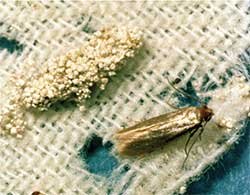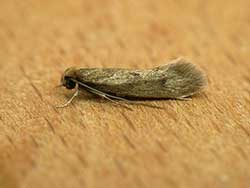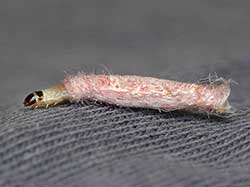Fact Sheet FS1182

Figure 1: Webbing clothes moth larvae and adult.

Figure 2: Casemaking clothes moth adult

Figure 3: Casemaking clothes moth larva
The webbing clothes moth (Tineola bisselliella (Hummel)) and casemaking clothes moth (Tineola pellionella L.) are occasionally found in homes infesting wool, fur, leather, and other animal materials. The webbing clothes moth is a serious pest in museums and can cause major economic loss in drapery shops and rug stores.
Identification
The webbing clothes moth adult is covered with shiny golden scales, and the top of the head bears fluffy reddish golden hairs. The body length is about ¼ inch (6 mm). Wingspan (from wing tip to wing tip) measures about ½ inch (13 mm). The wings are narrow and fringed with long hairs. The adult may be confused with pests infesting grains such as Angoumois grain moth and Indian meal moth. These moths are attracted to light and are found flying during the day. Webbing clothes moths avoid light.
The casemaking clothes moth wingspan is 3/8-½ inch (10–13 mm). The body and wings are buff colored to golden with three dark spots on each front wing.
Habits and Food
Webbing Clothes Moth
Average life span of adult males and females are 28 and 16 days, respectively. Each female lays 40–50 eggs, and oviposition lasts for several weeks. Eggs are deposited among the threads and are fastened by a gelatinous material so that they do not readily shake off. The eggs hatch after 4–10 days. The larval stage lasts about 67 days, but can be as long as 29 months. The larvae prefer to feed in hidden places such as under collars, on the underside of carpeting, etc. They typically feed in a silken tunnel. When the larvae feed in more exposed situations, they usually spin a silken mat or patch and feed from beneath it. The mature larva spins a pupal case of silk. The size of the case varies from 1/6-¼ inch (4–6 mm) in length. Pupal stages range from 8–44 days. Adults do not eat and cause no damage.
Adult webbing clothes moth can be found year-round in a warmed building. The males are attracted to females by a pheromone released from the female.
Casemaking Clothes Moth
This species is less commonly encountered and far less economically important than the webbing clothes moth. Unlike the webbing clothes moth, casemaking clothes moth larvae feed inside of silken burrows spun over the fabric surface. Only their heads and legs appear outside, but from either end of the case. The larva will die if separated from the case. The larva usually grazes here and there, causing only surface furrows, but may occasionally cause holes. It rarely spins silk on the material. As the larva grows, it lengthens the case with a series of additions to either end. When the larva is ready to pupate, it moves to a protected site such as a crevice in the wall or ceiling. It is also possible for the larva to pupate without leaving its food substrate.
Prevention and Control
Proper storage is most important. Valuable furs and other items of animal origin may be placed in cold storage where temperatures remain below 40°F. Larvae are inactive at temperatures below 40°F. Airtight garment bags are excellent tools for storing valuable objects. Before storing the articles, carefully examine them to make sure they are clean and pest-free.
Tight chests or cabinets are not adequate for protecting woolens for long periods of time. Naphthalene or paradichlorobenzene (PDB) placed in storage cabinets will prevent damage. These products should not be placed in direct contact with the articles. PDB can damage plexiglas®, many resins and furniture finishes, buttons, and ornaments on clothing.
Non-Chemical Control Methods
Inspection
Visually check woolens, linens, furs, and other suspected articles. Placing sticky traps is helpful for determining the location of the infestation. Pheromone traps containing female pheromones are commercially available. These traps are much more effective than plain sticky traps. Male moths can be attracted to pheromone traps 16–24 ft (4–6 m) away. Place the traps on floors or shelves or any horizontal surfaces near suspected infestations. Check the traps every one or two weeks.
Dry Cleaning and Hot Laundering
Garments can be dry cleaned or hot laundered to kill all fabric pests.
Freezing
Non-washable items can be wrapped inside a plastic bag and placed in a household freezer for two weeks. After the treatment, the objects should be allowed to return to room temperature within the sealed plastic bag to prevent condensation damage.
Chemical Control Methods
Dichlorvos (DDVP) impregnated resin strips (such as Nuvan® Prostrips, Vapona®) are available for repelling and controlling fabric pests. Vapona® strips can be used to treat museum display cases, storage closets, attics, storerooms, and other enclosed areas that are not regularly occupied by persons. When using them, be careful not to let them contact the article to be treated and select the right size according to the size of the space being treated. In occupied homes, Nuvan® Prostrips can be used in closets, wardrobes, cabinets, and attics. Dichlorvos is slowly released from the strip and when high enough concentrations are reached, it will kill any pests hiding on the treated articles. Closets are not airtight and are opened too frequently to hold enough vapors to kill insects. A trunk, chest, box, or garment bag makes a good storage container for killing existing fabric pests with DDVP resin strips. The strips must be replaced every four months.
Insecticide Dusts or Sprays
Areas that cannot be cleaned may need to be treated with an insecticide dust or spray. Find a product that lists carpet beetles on its label. Diatomaceous earth dust is less toxic to humans than some other pesticides. Insecticide sprays containing pyrethrins may be directly applied to infested items such as edges of carpets and rugs. These sprays are not persistent, making them suitable for treating infested fabric materials.
Stuffed animals, pillows, some furniture, etc. cannot be sprayed with an insecticide. They can be fumigated with dry ice. Thick airtight plastic bags can be used for dry ice fumigation. For each 42-gallon heavy duty garbage bag (3 mil), place 3 pounds (1,350 g) dry ice pellets near the bottom or center of the bag. Seal the bag with a string. Dry ice will evaporate into carbon dioxide within a few hours (a process called sublimation). Carbon dioxide is heavier than air and as the dry ice sublimates, air in the bag is pushed out. As long as the bag is tightly sealed with string, the air inside the bag will contain a very high concentration of carbon dioxide for at least 2–3 days. A 48-hour fumigation at around 70°F is sufficient for killing any fabric pests. Longer time will be required at lower temperatures. Wear gloves when handling dry ice. Conduct the treatment in a vented place to avoid accumulation of high carbon dioxide level in the room.
References
Mention or display of a trademark, proprietary product, or firm in text or figures does not constitute an endorsement by Rutgers Cooperative Extension and does not imply approval to the exclusion of other suitable products or firms.
Photo credits: Clemson University - USDA Cooperative Extension Slide Series, Bugwood.org (Figure 1); Charles Baker (Figure 2); Patrick Clement (Figure 3).
June 2012
Copyright © 2024 Rutgers, The State University of New Jersey. All rights reserved.
For more information: njaes.rutgers.edu.
Cooperating Agencies: Rutgers, The State University of New Jersey, U.S. Department of Agriculture, and Boards of County Commissioners. Rutgers Cooperative Extension, a unit of the Rutgers New Jersey Agricultural Experiment Station, is an equal opportunity program provider and employer.

